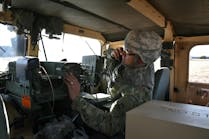Recent assessments of U.S. port security reveal vulnerability to terrorists using speedboats in an attack, making port security a central issue in the global war on terror. Professionals overseeing the U.S. Department of Defense Joint Non-Lethal Weapons Directorate have been investigating solutions capable of bolstering harbor security in the U.S. and at military bases abroad. They have opted to invest in a ballistically deployed net technology developed and patented by Foster-Miller Inc. in Waltham, Mass.
Foster-Miller, according to a new $1 million contract, will further develop the Boat Trap system alongside Moscow Mills Manufacturing in Vermont, the Joint Non-Lethal Weapons Directorate, and the U.S. Coast Guard.
Boat Trap is a nonlethal, ballistic net that is deployed from a helicopter into the path of a threatening watercraft traveling at a high rate of speed. This net-based propeller entangling system ensnares the propellers of a target speedboat, causing the craft to immediately stop.
The Boat Trap system, planned for use by the U.S. Coast Guard and the U.S. Navy offers an alternative to the use of firepower in defense against a perceived threat in a crowded harbor, without posing a threat to bystanders and infrastructure.
The Boat Trap system was tested at the U.S. Coast Guard Special Mission Training Center (SMTC) at Camp Lejeune, N.C.; South Padre Island, Texas; and Honolulu, Hawaii-where the system stopped 100 percent of its targets. For more information, visit www.foster-miller.com.


